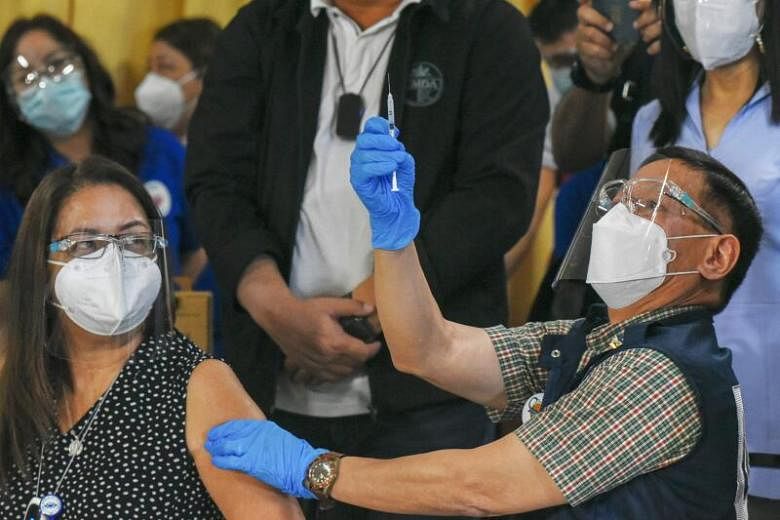MANILA (PHILIPPINE DAILY INQUIRER/ASIA NEWS NETWORK) - Heartbreaking stories of Covid-19-afflicted Filipinos dying while their families frantically rushed from hospital to hospital begging for accommodation show just how grim the reality has become on the ground, despite the government's pronouncements that hospitals are not full and that it has done an "excellent" job of responding to the pandemic.
"My dad died in the cold," netizen Angelo B shared in a series of tweets detailing his family's harrowing ordeal.
On March 27, when his father had difficulty breathing, the family called 20 hospitals and the government-run One Hospital Command Center, and brought him to eight nearby hospitals.
"This was the worst part," Angelo B wrote: "Every. single. hospital. Every one of them was full."
Not one hospital could refill his father's oxygen tank as well. They had no choice but to bring him home. At 3 am the next day, the father stopped breathing. Again, they rushed him to a hospital, but it did not have an ICU.
At a bigger hospital, they were told that there were two other patients ahead. Angelo B's father was put on a stretcher with an oxygen tank outside the door of the ER, literally a few breaths away from the ICU, and that's where he expired soon after.
Melchie Garcia of Novaliches, Quezon City shared a similar nightmare in a TV interview: They went to 11 hospitals on March 29 as his father had fever, cough, and difficulty breathing.
Their search took them to as far as San Fernando, Pampanga, but they could not find a hospital that would admit his father. They also called the One Hospital Command Centre, but were told they would be 32nd in line.
They finally found a hospital in Valenzuela, where the father was admitted after 12 hours of waiting. "I said, Pa, keep on fighting. We will go to Batangas or Laguna just to find a hospital,' Garcia said.
Rich or poor are not spared the anguish of not finding a proper place for healing, as shown by the death of singer Claire de la Fuente, who passed away at a hospital ER after waiting for two days in a tent.
And if they are fortunate enough to get into a tent, some patients needed to shell out P1,000 (S$27) per hour without PhilHealth coverage, Bayan Muna party list Rep Ferdinand Gaite disclosed in a House hearing last week.
One colleague, he said, paid P140,000 for a few hours in a hospital tent, "even more than in an ICU and, worse, it's not covered by PhilHealth."
PhilHealth acting senior vice president Neri Santiago confirmed in the same hearing that "For now, tents are not accredited since there are no standards for them yet."
Health Secretary Francisco Duque III's reaction to the appalling state of affairs pointed out by Gaite was to employ bureaucratic pettifoggery, saying it was "unacceptable" and that "we already upgraded this benefit package to be inclusive of different levels of accommodation."
The Department of Health also insisted that "hospitals are not full yet," and that 93 per cent of Covid-19 patients supposedly have mild symptoms and do not need hospitalisation.
On March 31, around the time Angelo B and Garcia were at their wits' end trying to find a hospital for their fathers, the department reported that only 79 per cent of ICU beds in Metro Manila were occupied, and 69 per cent of isolation beds and 60 per cent of ventilators were in use.
Contrast that official picture with many hospitals in Metro Manila announcing that they were no longer accepting Covid-19 patients after having reached full capacity, and with hospitals in neighbouring provinces also being crammed with patients from the NCR.
The Philippine Orthopedic Center closed down its outpatient department after 110 of its 180 health care workers tested positive.
The Lung Centre of the Philippines said on Saturday (April 3) that its ER was 200 per cent full and its Covid-19 wards were at 100 per cent occupancy.
The One Hospital Command Centre is also a stark failure. Health Undersecretary Leopoldo Vega admitted that the number was sometimes unreachable because it supposedly did not have a call forwarding feature.
With only 30 personnel manning the centre, it was unable to cope with calls that grew from 70 calls per day in February to 400 calls per day in recent weeks.
Marikina Rep Stella Luz Quimbo called this a "very lame excuse."
The centre, after all, was put up by the Inter-Agency Task Force for the Management of Emerging Infectious Diseases last year to become a centralised hospital monitoring and referral centre, and it had all these months to beef up the facility.
When asked by Quimbo what patients unable to reach the government's hotline should do, Duque said they should ask their personal doctors for advice if they should go for alternatives to hospitalisation.
That's the country's top health official essentially telling the people that they are on their own - exactly what's happening on the grounds and driveways of hospitals at this time, as desperate citizens see their loved ones expire without the helping hand of their government.
The Philippine Daily Inquirer is a member of The Straits Times media partner Asia News Network, an alliance of 23 news media organisations.

